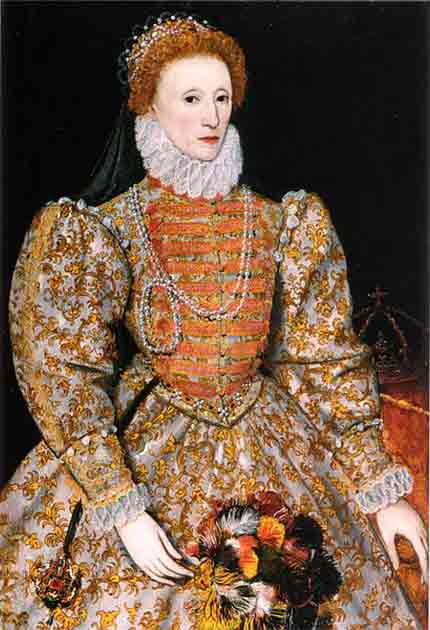Today Queen Elizabeth I is one of England’s best-remembered monarchs, but she wasn’t always so popular. Throughout her reign (spanning from 1558 to 1603), she navigated a perilous era marked by political intrigue and religious tensions.
fact, there were several high-profile assassination plots aimed at dethroning her, the most notable of which were the Ridolfi, Throckmorton, and Babington plots. Although led by different figures these three plots against Elizabeth were all surprisingly similar and all made the same mistake.
The conspirators underestimated one of history’s greatest-ever queens and the incredibly impressive spy network she wielded. It was the latter in particular, and her increasingly secure position as queen, that ensured she remained untouched until her death.
The Ridolfi Plot
Our first plot against Elizabeth was conceived by Roberto Ridolfi, a Florentine banker and diehard Roman Catholic who began plotting as early as 1569. He had been involved in the Northern Rebellion of 1569, an attempted uprising by the Catholic nobles in the northern regions of England, which had ultimately failed.
Undeterred, he saw the failure of that uprising as only the opening salvo. His ultimate goal remained the same: to overthrow Queen Elizabeth I, restore Catholicism, and place Mary, Queen of Scots, on the English throne.

Ridolfi recognized he needed help, and his first step was to seek foreign intervention to aid him in achieving his goals. He teamed up with Mary’s chief advisor, John Lesley, the Bishop of Ross, and laid out his plan. The Catholic Duke of Alba with a 10,000-strong invasion force would sweep in from the Netherlands and incite a rebellion among England’s largely Catholic Northern nobility.
Ridolfi estimated around half the northern nobility was Catholic and could rally over 39,000 men between them. With this force, Ridolfi and his co-conspirators could assassinate Elizabeth and marry Mary to Thomas Howard. Simple enough.
The Duke of Norfolk, a prominent northern noble, would help lead the revolt. Ridolfi approached him and the Duke, despite being raised Protestant as a child, verbally affirmed his Catholic allegiance to Ridolphi.
Both Mary and Norfolk, driven by desperation to rectify their situations, endorsed the conspiracy. With the blessings of Mary and Norfolk, Ridolfi embarked on a diplomatic mission to the Continent, seeking support from the Duke of Alba, Pope Pius V, and King Philip II.
- Did Queen Elizabeth Murder Robert Dudley’s Wife?
- Fireships in the Night: How was the Spanish Armada Defeated?
Unfortunately for Ridolfi Elizabeth already had an extensive intelligence network and her spies ensured the plot never left the drawing board. Crucial correspondence between Ridolfi and his allies was intercepted, leading to the arrests of key conspirators, including the Duke of Norfolk. Through the use of torture and the threat thereof, the conspirators admitted to the plot one by one.
Ridolfi was never actually caught or executed but the plot was ultimately called off. As the conspiracy became somewhat of an open secret across Europe, Ridolfi’s major backers, like the Duke of Alba, lost confidence in him and canceled the whole thing. Ridolfi lived one until 1612, something that couldn’t be said about most of those caught by Elizabeth’s spies.
The Throckmorton Plot
The next major plot against Elizabeth was shockingly similar to Ridolfi’s plan. Led by Francis Throckmorton, a scion of a prominent English Catholic family, the plot revolved around freeing Mary from her house arrest in England, making her Queen, and reinstating Roman Catholicism across England.

Much as Ridolfi had relied on the Duke of Alba, Throckmorton planned on a Spanish-backed invasion led by the French Duke of Guise, concurrently supported by a revolt of English Roman Catholics. Once again, a political marriage would seal the deal, this time between Guise and Mary, which would solidify the man’s claim to the English throne.
Between 1580 and 1583 Throckmorton traveled across Europe meeting prominent Catholic exiles like Charles Paget and Thomas Morgan who had escaped to Paris. Throckmorton’s correspondence, carrying messages between Mary, Thomas Morgan, and Bernardino de Mendoza (Philip II of Spain’s ambassador in London), was routed through the French embassy in London. When Throckmorton returned to England in 1583, he was ready to get his plan in motion.
However, Throckmorton’s somewhat amateurish approach soon became evident, as he was swiftly placed under surveillance upon his return. A French Embassy agent had tipped off Francis Walsingham, Elizabeth’s Secretary of State and Throckmorton was arrested in November 1583.
On his person, he had incriminating documents, including lists of English Catholic supporters. Unfortunately for him, his encoding of a letter to Mary, Queen of Scots, at the time of his arrest revealed the extent of the plot.
Throckmorton was tortured and soon confessed to having given the Spanish ambassador a list of suitable havens on the English coast. His trial began in May 1584, and he was executed on July 10.
He was the only conspirator in this plot to face such a fate. The Throckmorton Plot, although never set into motion, exposed Spanish involvement in the quest to overthrow Elizabeth I.
The Babington Plot
Just two years after the previous attempt had failed Eizabeth’s life was once again in danger. The masterminds behind this particular plot were Anthony Babington and John Ballard.
Babington, a young recusant, was recruited by Ballard, a Jesuit priest determined to rescue the Scottish queen. The ultimate goal was to instigate the invasion of England by Spanish forces led by King Philip II and the Catholic League in France, thereby restoring Catholicism. Sounds a little familiar.
Sir Francis Walsingham, Elizabeth’s spymaster, played a key role in unraveling the conspiracy. Working with double agents such as Robert Poley and Gilbert Gifford, and utilizing the services of spy decipherer Thomas Phelippes, Walsingham orchestrated a plan to intercept encrypted communications between Babington and Queen Mary.
Gifford, having obtained a letter of introduction to Queen Mary through Thomas Morgan, successfully infiltrated Chartley Castle where Mary was imprisoned. There he gained access to the Queen of Scots.
The turning point came on July 7, 1586, when Phelippes decoded a letter from Babington to Mary. In response, Mary, on July 17, 1586, in code, sanctioned the assassination of Queen Elizabeth. The letter not only exposed Mary’s involvement but also revealed her desire to be rescued.

At the subsequent trial in October 1586, Elizabeth’s advisors, including Lord Burghley and Walsingham, used this evidence against Mary. Despite her refusal to admit guilt, Mary’s secretaries Nau and Curle, under pressure, confessed to the letter’s authenticity, sealing Mary’s fate.
She had been implicated in one plot too many and was executed on February 8, 1587, beheaded at Fotheringham Castle in England. And with Mary gone, the Catholic designs were now in ruins.
Why So Persistent?
This all raises the question: why were people so determined to get rid of Elizabeth? After all, she has a whole golden age named after her and most historians agree she played a pivotal role in turning England into the global powerhouse it would later become.
Well, as a Protestant monarch in a predominantly Catholic Europe, Elizabeth’s religious affiliation was a constant source of tension. Her reign witnessed the intense polarization between Catholic and Protestant factions, leading to numerous attempts on her life and attempts to replace her with a Catholic ruler.
Elizabeth was also famously “married to England” and the absence of a clear heir fueled the plots against her. With her being unmarried and childless, the question of succession loomed large, creating uncertainty, and providing opportunities for ambitious individuals or factions to seek alternative rulership. With no heir, plotters felt she would be “easy to replace.”

Elizabeth’s general success also played against her. In particular, her foreign policy decisions further heightened animosities. Her opposition to Catholic Spain, epitomized by the defeat of the Spanish Armada in 1588, intensified hostilities, making her a prime target for Catholic conspirators seeking to restore the old religion.
Luckily for Elizabeth, she had an incredible intelligence network, led by Sir Francis Walsingham. Her intricate web of spies, double agents, and cryptanalysts played a crucial role in unveiling and thwarting conspiracies, ensuring the queen’s security. Despite the number of plots against her, Elizabeth was rarely in any real danger.
In the face of relentless conspiracies and threats from at home and abroad, Queen Elizabeth I’s reign stands as a reminder of her impressive political acumen and what made her such a successful monarch.
The Ridolfi, Throckmorton, and Babington plots posed serious threats, but they all failed, thwarted by Elizabeth’s loyal spies. With each plot against her, she only grew more powerful.
Top Image: Mary, Queen of Scots (left) was the focus of the three major plots against Elizabeth I (right). Source: François Clouet / Public Domain; Workshop of Steven van der Meulen / Public Domain.